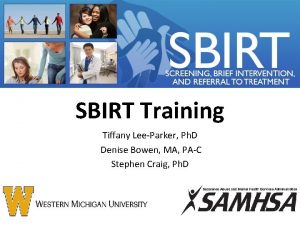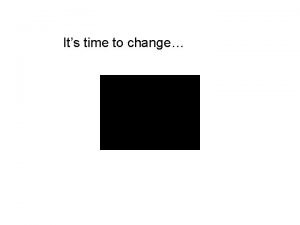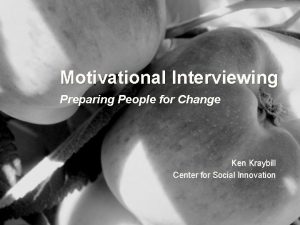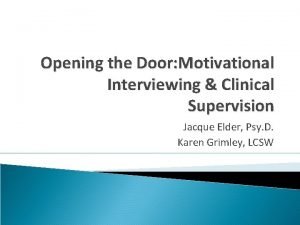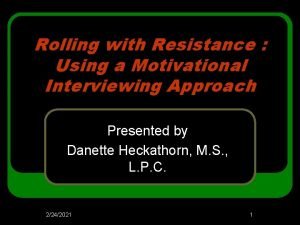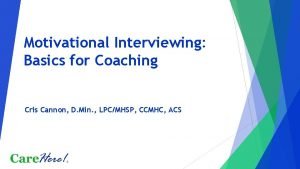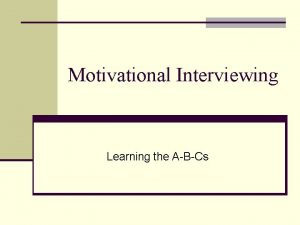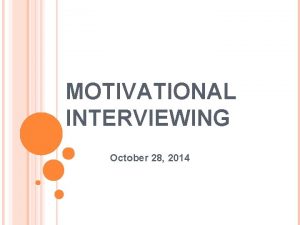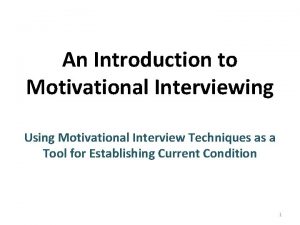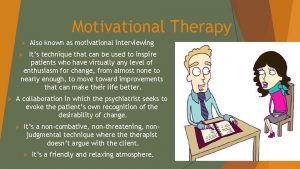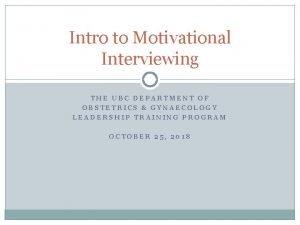Motivational Interviewing in a healthcare setting CHAD ANDERSON
























- Slides: 24

Motivational Interviewing in a healthcare setting CHAD ANDERSON, MA, LPC INTERN METROCARE SERVICES ACT TEAM 3 CLINICAL MANAGER

Objectives: • Introduce MI • Provide overview of general concepts of stages of change and internal motivation • Discuss roles and uses of MI • Explain how MI can be used to improve collaboration and outcomes • Discuss concepts, tools, and features of MI

So what is Motivational Interviewing? “A person-centered, goal-oriented approach for facilitating change through exploring and resolving ambivalence. ” (Miller & Rollnick, 2006) “A way of being with people. ” (Miller & Rollnick, 2002) A way of discovering the importance of change and ambivalence as well as the reason or reasons for it Aware of resistance and obstacles to change Linked to the stage model of change (Prochaska & Di. Clemente, 1982) Person centered, empathic, supportive, evocative, guiding, collaborative (Miller & Rollnick, 2002) Focuses on choice and autonomy About the patient/client, not us Works to inform the patient/client through carefully thought out choices based on their internal motivation to make decisions

Stages of change and internal motivation Prochaska & Di. Clemente identified six stages of change Precontemplation, Contemplation, Preparation, Action, Maintenance, and Relapse We encounter people at different points along this construct, and each requires a slightly different approach in treatment We want to be with the patient/client and listen to what is important to them; they may not want to change or may not be actively engaged in change behaviors or they may be well engaged In order for change to occur, several internal factors have to line up; think of a Venn diagram where importance, self-efficacy, and readiness are moving together Through MI, we want to help those circles overlap

Stages of change and internal motivation Resistance to change and ambivalence are normal MI seeks to help the client/patient to examine their goals, develop discrepancy between what they do and what they want, explore their options, review obstacles, and make an informed choice towards change When the motivation for change is internal versus external, change is more likely to achieve success and more likely to persist over time By remaining supportive and collaborative we work with the patient/client as opposed to having a hierarchical relationship where as the expert we tell them what’s best or what they have to do

Roles and uses of MI was originally developed for the treatment of substance abuse (Miller, 1983) It is now used for a variety of behaviors, addictions, and other life choices Can be used when a client/patient is resistant to treatment or change Can be used to help a client/patient that is “stuck” and not sure where to go

How can MI help improve collaboration and outcomes? The patient-provider relationship has been found to have an impact on the success of treatment (Beach, Keruly, & Moore, 2005) When the client patient feels that the provider knows them personally and the relationship is viewed as an equal partnership, treatment adherence may be improved (Jin, Sklar, Oh, Li, 2008) The perception of poor communication and a lack of interest can lead to poor adherence (Bartlet, Grayson, Barker, et al, 1984) By following the spirit of MI, we can hope to build a strong therapeutic relationship and improve treatment and outcomes

Motivational Interviewing: Concepts, tools, and features The “Spirit of MI” can be thought of as: Elicited from within through quiet support Having the client resolve ambivalence by helping them through the process Avoid direct persuasion Recognize that change is not a trait, but a fluid state influenced by therapeutic relationship The relationship is a partnership, not a lecture (Rollnick & Miller, 1995)

Motivational Interviewing: Concepts, tools, and features (continued) Ambivalence and change: Ambivalence to change is normal and understandable Why don’t they just change? Because something about the behavior works for them. How do we address that? By education, developing the process, suggesting, and guiding them through their ambivalence and addressing potential obstacles.

Motivational Interviewing: Concepts, tools, and features (continued) Four key principles: Develop discrepancy Help the process of change by showing the difference between behavior and goals Seek out how important it is to the client to make the change Express empathy Use reflective listening Accept the client/patient in a non-judgmental way, recognizing that acceptance does not mean agreement Make it clear that ambivalence is normal

Motivational Interviewing: Concepts, tools, and features (continued) Four key principles (cont. ) Roll with resistance Arguing results in power struggles When resistance is met, we need to remember that it’s not about us, and this is the time for the clinician to change Reflect problems back to them, don’t solve them for the client/patient Support self-efficacy Reinforce the client/patient’s capability to change Be genuine and accepting in your approach Be aware of the client/patient’s responsibility

Motivational Interviewing: Concepts, tools, and features (continued) Stages of change: Precontemplation- No problem Bring awareness to the issue Be encouraging Contemplation- There might be a problem Increase awareness Provide options and benefits of change Preparation- Ok, I need to make a change Provide resources and information Offer assistance Address barriers and obstacles Reinforce self-efficacy

Motivational Interviewing: Concepts, tools, and features (continued) Stages of change (cont. ): Action- I am making changes Encourage progress Develop realistic goals (SMART) Continue to support and offer resources Maintenance- I knew I could do it Help maintain progress and momentum Isolate or minimize chance for relapse Relapse- I knew this would happen Normalize that relapse happens Recognize even slow progress is still progress Assist in planning recovery, the gift of fear Keep engaged in services “Look up, get up; don’t ever give up. ”

Motivational Interviewing: Concepts, tools, and features (continued) OARS: Open-ended questions Elicit change talk Hard to carry conversation with yes/no questions Show clinician interest in the client/patient Affirmations Encourages self-worth Establish air of success Focus on attributes, abilities, and effort

Motivational Interviewing: Concepts, tools, and features (continued) OARS (cont. ): Reflective listening Show that you’ve been paying attention Highlight statements showing client/patient movement Recognize both sides of any ambivalence Kind of a mini-summary Opportunity to point out discrepancy using their own words Summaries Restate their view overall Provide the opportunity to clear up misunderstanding Use when you’re stuck or in circle-talk Use when you’re not sure of the problem or how big/important it is Allow this process to lead to new ideas

Motivational Interviewing: Concepts, tools, and features (continued) DARN-C (Change Talk): Where the change talk lives Desire Ability There is something keeping the client/patient where they are Need Emphasize the client’s efficacy to change Reasons Does the client want to get better/change? What is internal to the client that will motivate them to change? Commitment What is the client/patient willing to do to make the change?

Motivational Interviewing: Concepts, tools, and features (continued) Roll with resistance: Accept their fears and concerns Suggest or point out the concerns of others Reframe their concerns or obstacles in a positive way Offer assistance and suggestions Do not take resistance as a personal failure or your responsibility Resist the righting reflex Do not be the expert Be accepting and appreciative of their position Keep OARS-ing

Motivational Interviewing: Concepts, tools, and features (continued) Decision matrix: Present the decision as a matrix List the pros and the cons for change List the pros and the cons for not changing Talk through each choice and evaluate how either would impact the client/patient Start OARS-ing

Motivational Interviewing: Concepts, tools, and features (continued) Key Processes of MI: Engage Focus Set an agenda, arrive at negotiated mutual goal, explore ambivalence, be a consultant that provides info and advise (with permission) Evoke Listen to understand, just be with the client Elicit information, respond empathically, provide summaries, listen for change talk (DARN-C) Plan Foster and facilitate movement towards change and set the commitment

Things to keep in mind when using MI We want SMART goals: Specific, Measurable, Achievable, Realistic, Timely Using MI should be goal-directed We want to examine and resolve ambivalence We want to assume that on some level, there is within the client/patient a desire to change: there is some reason they walked in the door While it is important to remember methods and techniques, it is just as important to remember that MI is a way of being with the client/patient If you focus too much on “the book” you risk losing the relationship, which is the spirit of MI MI should be thought of as a style rather than a collection of techniques Balance guiding the client through the change process with coercing them to do what we want

Being consistent with MI Seek to understand their view; using reflective listening will help in this Express acceptance and use affirmations to reinforce this Discriminate the client/patient’s positive-oriented internal motivation and identification of problems Reinforce their intent and desire to change as well as their self-efficacy to make those changes Constantly monitor their readiness for change, “dance” with the client/patient, and don’t jump ahead of them Be prepared for resistance Support and recognize the client/patient’s freedom and self-determination

Differences with other directive approaches MI does not argue with the client/patient, or tell them that they need to change Doesn’t intervene directly by giving advice or solutions without first asking their permission, and then encouraging them to arrive at their own decision Doesn’t use an authoritative or expert approach where the client is along for the ride Doesn’t do most of the talking, information should flow both ways with the client/patient doing most of the talking Diagnostic labels are not the focus Isn’t judgmental or coercive Is more goal-oriented than nondirective counseling MI should not be a mind trick or manipulation that is “used on” the client/patient

References Bartlett EE, Grayson M, Barker R, et al. The effects of physician communications skills on patient satisfaction; recall, and adherence. J Chronic Dis. 1984; 37: 755– 64. Beach, M. C. , Keruly, J. , Moore, R. D. (2006). Is the quality of the patient-provider relationship associated with better adherence and health outcomes for patients with HIV? Journal of General Internal Medicine, 21(6), 661 -665. Jin, J. , Sklar, G. E. , Min Sen Oh, V. , & Chuen Li, S. (2008). Factors affecting therapeutic compliance: A review from the patient’s perspective. Therapeutics and Clinical Risk Management, 4(1), 269– 286. Miller, W. R. (1983). Motivational interviewing with problem drinkers. Behavioural Psychotherapy, 11, 147 -172. Miller, W. R. , Rollnick, S. (2002). Motivational Interviewing: Preparing People For Change (2 nd ed. ). New York: Guillford. Prochaska, J. O. , Di. Clemente, C. C. (1982). Transtheoretical Therapy: Toward a more integrative model of change. Psychotherapy: Theory, Research and Practice, 19(3), 276 -88. Rollnick S. , & Miller, W. R. (1995). What is motivational interviewing? Behavioural and Cognitive Psychotherapy, 23, 325 -334.

Chad Anderson, MA, LPC Intern Clinical Manager, ACT Team 3, Metrocare Services Westmoreland Clinic 1350 North Westmoreland Dallas, TX 75211 214 -689 -5174 Chad. Anderson@metrocareservices. org
 German motivational speech
German motivational speech Reds motivational interviewing
Reds motivational interviewing Motivational interviewing
Motivational interviewing Mi readiness ruler
Mi readiness ruler Change talk worksheet
Change talk worksheet Dears motivational interviewing
Dears motivational interviewing Darn cat motivational interviewing
Darn cat motivational interviewing Motivational interviewing
Motivational interviewing Darn cat motivational interviewing
Darn cat motivational interviewing Dears motivational interviewing
Dears motivational interviewing Motivational interviewing
Motivational interviewing Jeremy wampler
Jeremy wampler Desire ability reason need
Desire ability reason need Motivational interviewing
Motivational interviewing Decisional balance
Decisional balance Motivational interviewing schizophrenia
Motivational interviewing schizophrenia Motivational interviewing
Motivational interviewing Dares motivational interviewing
Dares motivational interviewing Darn cats motivational interviewing
Darn cats motivational interviewing Krishna guadalupe
Krishna guadalupe Motivational interviewing stages of change
Motivational interviewing stages of change Agreement with a twist motivational interviewing
Agreement with a twist motivational interviewing Motivational interviewing rolling with resistance
Motivational interviewing rolling with resistance Motivational interviewing
Motivational interviewing Motivational interviewing basics
Motivational interviewing basics








